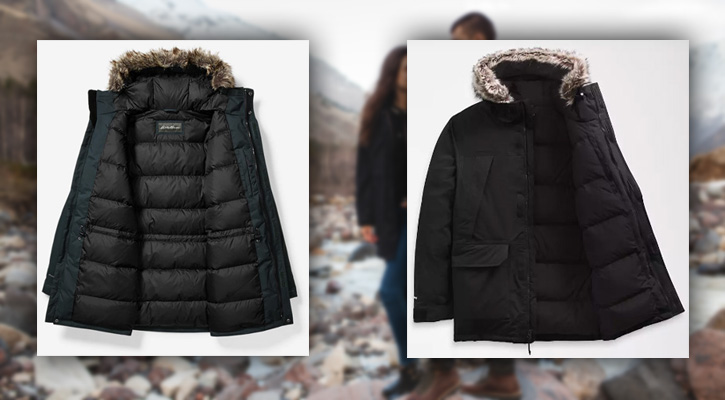
Embarking on an outdoor adventure requires gear that’s both reliable and resilient.
Eddie Bauer and The North Face have been offering equipment to wilderness enthusiasts for decades, with Eddie Bauer introducing the first down jacket in the U.S., and The North Face providing high-performance mountain gear since 1966.
In this article we’ll compare these two iconic brands, examining their innovations in outdoor apparel, commitment to sustainability, and standout products.
We’ll also discuss their pricing and the value they offer to ensure you’re well-equipped for your next foray into the wild.
Let’s get started!
Contents:
1. Eddie Bauer Outdoor Gear
History of the Brand
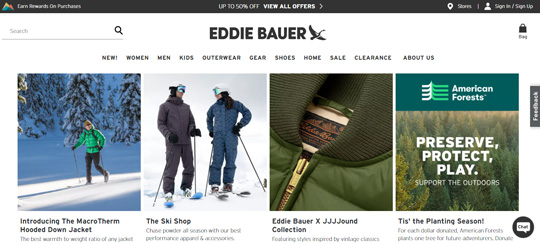
Eddie Bauer’s official website
Eddie Bauer boasts a century-long heritage, originating in 1920 in Seattle, Washington, USA. Throughout its history, the company has been recognized for its innovations, including the pioneering development of the inaugural down jacket in the United States.
Renowned for its outdoor apparel, particularly footwear, and outerwear, Eddie Bauer has garnered numerous accolades. Notably, the company supplied equipment for the historic 1963 American expedition to Mount Everest, as well as subsequent significant ascents such as Dhaulagiri in 1973 and Makalu in 1980.
Emphasizing sustainability and renewable resources, the company currently operates more than 200 retail outlets across the United States, solidifying its position as a leading brand in the outdoor product sector.
Don’t miss:
9 Outdoor Brands like Eddie Bauer: Our Favorites
Eddie Bauer vs L.L. Bean Outdoor Gear: A Comparison
Materials, Fabrics, and Production Process
The production of jackets and other products by Eddie Bauer primarily relies on the use of Polyester and Nylon, along with the incorporation of WeatherEdge® technology for waterproof and breathable properties.
Additionally, the utilization of Thermafill® for synthetic insulation and StormDown, which involves treating down with DWR coating for improved moisture resistance, are common practices.
Eddie Bauer also incorporates Thindown, an innovative Italian fabric, into some of their garments to provide insulation with similar qualities to natural down but with enhanced resistance to adverse weather conditions.
The brand is dedicated to sustainable design, emphasizing the use of environmentally friendly materials such as recycled polyester and nylon, as well as responsibly sourced man-made cellulose fibers.
Also, Eddie Bauer actively engages in environmental conservation efforts through collaborations with organizations like American Forests, promoting urban reforestation and striving for equity and inclusion within their community and industry. You can read more about Eddie Bauer’s sustainability efforts on their website.
The video will be loaded from YouTube.com, a third party. If you play it, you accept their terms of service, and their use of cookies.
Read also: Eddie Bauer vs Lands’ End Outdoor Gear: A Comparison
Where is Eddie Bauer’s outdoor gear made?
Eddie Bauer’s outdoor apparel and equipment are predominantly made in Asian countries like Vietnam, China, India, Pakistan, and Indonesia.
Recommended Products
Eddie Bauer Men’s Superior Down Parka
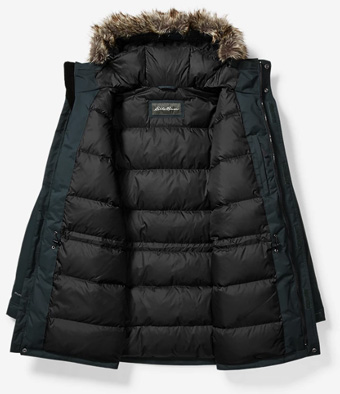
Image: eddiebauer.com
Check it out at EddieBauer.com
The Eddie Bauer Men’s Superior Down Parka presents a durable winter jacket crafted to withstand extreme weather conditions. It includes a waterproof and breathable recycled nylon shell with WeatherEdge® technology and StormRepel® Super DWR finish to resist rain.
The parka is equipped with 650-fill-power premium down for insulation, providing warmth in below-freezing temperatures. Additionally, it features inner rib-knit storm cuffs, secure zip pockets, an adjustable hood with removable faux fur, and an action back construction for enhanced mobility.
The relaxed fit allows for comfortable layering, ensuring a blend of functionality and comfort for winter conditions.
Eddie Bauer Adventurer® Trail Backpack
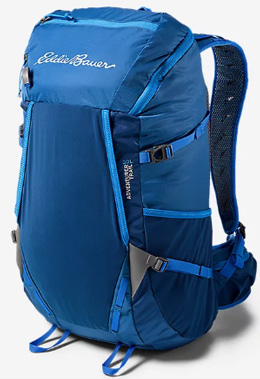
Image: eddiebauer.com
Check it out at EddieBauer.com
The Eddie Bauer Adventurer Trail Backpack is a versatile pack intended for various outdoor activities, ranging from short hikes to extended technical climbs. Constructed with durable 70-denier shadow ripstop nylon, it can endure the demands of the trail while remaining lightweight.
Boasting a 30L capacity, it provides ample space for all your essential gear. Comfort is a priority, with the inclusion of the FreeCool® trampoline airflow back panel, offering cushioning for your load and promoting ventilation to prevent overheating during vigorous activity.
Hydration is easily managed with the pack’s hydration options, ensuring convenient access to water on the move. For organization, it includes a Power Mesh front pocket for storing rain gear or an insulating layer. Additionally, a top lid pocket provides a secure spot for items that require quick access without opening the main compartment.
Practicality is evident in the design, with side compression straps for load balance and stability, ensuring a compact and manageable load. Strategically placed tool loops keep essential gear such as trekking poles or ice axes within easy reach.
Prices
If one were to purchase an Eddie Bauer item, it would be evident that the pricing falls within the accessible, mid-range. The cost of their jackets typically begins at approximately $60 and can go up to $300, whereas many of their backpacks are priced at less than $80. Although some backpack designs are pricier, they seldom surpass $200.
So, it’s a reasonably priced brand, especially considering the quality it provides.
Are Eddie Bauer products worth the price?
We can consider the two recommended items mentioned earlier. If you require something functional and adaptable, both are solid choices suitable for various situations, including outdoor pursuits and daily use. So, for multi-purpose items such as these, we believe Eddie Bauer offers reasonable pricing, making their products a good investment.
Read also: 10 Oldest Outdoor Clothing and Gear Brands
2. The North Face Outdoor Gear
History of the Brand
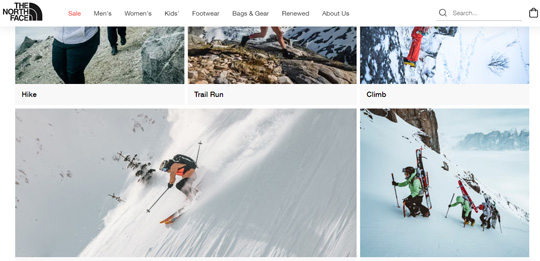
The North Face’s official website
The North Face stands as a popular American label within the outdoor gear community. It has garnered a strong following among outdoor enthusiasts, who have demonstrated enduring loyalty to its offerings over the years.
Since its establishment in 1966, the brand has maintained a steadfast focus on crafting technical mountain gear and attire, including hiking packs, tents, sleeping bags, ski clothing, and various other outerwear items.
The widespread appeal of The North Face transcended beyond technical wear in the 1990s, extending to a diverse clientele, including notable celebrities who embraced the brand’s products. A noteworthy instance occurred in 1993 when a rapper featured the Steep Tech jacket in a music video.
The brand’s name is derived from the concept of the ‘north face’ of a mountain in the northern hemisphere, symbolizing the part of the mountain that is the most frigid and difficult to climb.
Don’t miss:
11 Brands like The North Face: Our Top Alternatives
12 Best American Jackets and Outdoor Clothing Brands
Materials, Fabrics, and Production Process
The North Face predominantly utilizes Nylon and Polyester, common materials in outdoor gear, just like Eddie Bauer. The brand incorporates various technologies into its products, such as the FUTURELIGHT membrane, which features a thin nanomembrane allowing airflow while repelling water.
This membrane has been rigorously tested and proven effective in harsh outdoor conditions.
Additionally, The North Face integrates goose down for thermal insulation, offering customers comfort and warmth during extended trips. This lightweight insulation allows for ease of movement during strenuous activities.
The brand also leverages the renowned Gore-Tex technology to enhance its clothing with waterproofing, windproofing, and breathability. Gore-Tex effectively allows moisture to escape while preventing water from entering inside the jacket.
In addition, The North Face has developed many other technologies including DryVent, WindWall, FlashDry, and the popular ThermoBall synthetic insulation.
The video will be loaded from YouTube.com, a third party. If you play it, you accept their terms of service, and their use of cookies.
Read also:
The North Face vs Helly Hansen Outdoor Gear: A Comparison
The North Face vs Patagonia: Which is Better?
Where is The North Face outdoor gear made?
The majority of The North Face outdoor equipment is manufactured in Asian nations like China, India, Bangladesh, and Vietnam, with additional product lines produced in the United States.
Recommended Products
The North Face Men’s McMurdo Parka
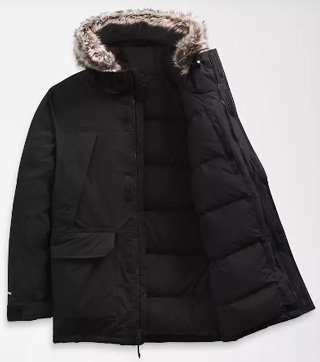
Image: thenorthface.com
Check it out at TheNorthFace.com
The McMurdo Parka is crafted to deliver exceptional warmth and shield from the elements and wind. This long coat offers a relaxed fit and is insulated with 600-fill-power recycled waterfowl down. The parka is windproof and waterproof, with its seam-sealed DryVent™ 2L shell with a non-PFC DWR finish that also offers breathability.
It has practical elements such as secure-zip chest pockets, dual-entry front pockets, and a secure internal chest pocket. It comes with an attached hood with a drawcord for adjustability and a detachable faux-fur ruff, along with a two-way front zip.
The parka is additionally detailed with an embroidered logo on the left chest and back-right shoulder, combining functionality with style. Adjustable hook-and-loop cuff tabs ensure a secure and comfortable fit, cementing the McMurdo Parka as a versatile choice for braving severe weather.
Read also: The North Face Diablo vs. Nuptse: Which Jacket is Better?
The North Face Borealis Backpack
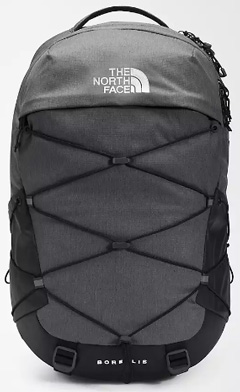
Image: thenorthface.com
Check it out at TheNorthFace.com
The Borealis stands out as a popular and adaptable pack crafted to deliver safety and utility for everyday requirements. Its distinctive bungee cord system and spacious interior compartment ensure secure storage for your belongings.
The backpack’s structure, detachable waist belt, chest strap, and safeguarded laptop section make it well-suited for diverse pursuits and settings. With its FlexVent™ suspension system, this backpack emphasizes comfort and stability, ensuring a pleasant fit even during hours of use.
For organization, the Borealis provides an external bungee-compression system and features a dedicated laptop compartment, a sizable main compartment, and a front compartment with internal organization, secure-zip pockets, and a tablet sleeve.
Made of recycled nylon and recycled polyester, this backpack not only offers great functionality but also aligns with the sustainability efforts of the brand.
Read also: How To Wash a North Face Backpack: Step by Step
Prices
The North Face is positioned in the mid-to-high price range, with their products generally being more costly compared to those of numerous other outdoor gear brands. For example, The North Face jackets are priced between around $70 and $800, while their backpacks can cost anywhere from $50 to $300.
Are The North Face products worth the price?
If you’re a serious mountain climber, hiker, skier, or outdoor enthusiast, The North Face gear is worth the investment in our opinion. Their equipment is made for comfort, utility, and high performance.
For casual everyday clothing, the answer to this question depends. But we think that even in this case, you can still find one or two affordably priced pieces of gear from The North Face making it worth it.
Learn more: Why Is The North Face So Expensive and Popular? Are Its Jackets Worth It?
3. Which is Better? Eddie Bauer or The North Face?
After examining the two brands separately, in our opinion, The North Face is likely the better choice overall for most outdoor enthusiasts and activities. Here’s why:
- The North Face specializes in technical, high-performance gear designed for more extreme mountain adventures, while Eddie Bauer is more focused on casual outdoor apparel. For serious hiking, climbing, etc. The North Face seems to have more options.
- The North Face integrates more innovative proprietary technologies into their products like FUTURELIGHT and DryVent membranes, and ThermoBall insulation. They also use the industry-standard Gore-Tex membrane. This gives their gear an edge in terms of functionality.
- The North Face is known for using high-quality materials that improve durability and weather resistance. This can justify the typically higher prices.
- For sustainability, both brands have initiatives in place.
- The North Face has a bit more name recognition among outdoor enthusiasts as a performance brand.
So, in the end, for most people planning intense outdoor activities or wanting very durable and functional gear, we’d recommend The North Face. However, Eddie Bauer can be a good option too for more casual use or if you’re on a tighter budget.
Read next: 9 High-End, Expensive Hiking Brands for Clothing and Footwear
